Steve Teichman, who has been the farrier for the United States Equestrian Team during the last three Summer Olympic Games, shapes a shoe during a shoeing stop in Pennsylvania.
The “fall-back” date from Daylight Saving Time is still a few days away, so Steve Teichman is preparing his truck for his day of Shoeing For A Living in the dark here in Chester County, a short drive southwest of Philadelphia.
Chester County Farrier Associates, the multi-farrier service that Teichman has been a partner in since the late 1980s, rents space in a complex used by a plumbing company in Downingtown. Teichman and his partner, Todd Meister, operate with a pair of apprentices and office manager Jessica Arthur. Today, Ben Fenstermacher, an apprentice who has just wrapped up his second summer show season working with Chester County, will ride along with Teichman. Dan Martzall, the other apprentice has been shoeing six years and is a graduate of Kentucky Horseshoeing School.
Chester County Farrier Associates also has “a couple of other guys” who ride along on a less-regular basis, according to Teichman. The service has a well-earned reputation in the equine community. Both Teichman and Meister, who is also a veterinarian, are known for combining craftsmanship with equine knowledge to benefit their clients.
7 a.m. Teichman is preparing for a light to normal day on this Thursday in October — typical, he says, for this time of year, which provides a much-needed respite between the hectic summer show season and the winter season that is still a few months away.
For Teichman, the past summer was even more hectic than usual. The farrier traveled with the United States Equestrian Team to the Beijing Summer Olympic Games. It was Teichman’s third Olympic Games and he’s also been overseas for numerous other international competitions, but he hints that he may back off from that part of his shoeing business in the not-too-distant future.
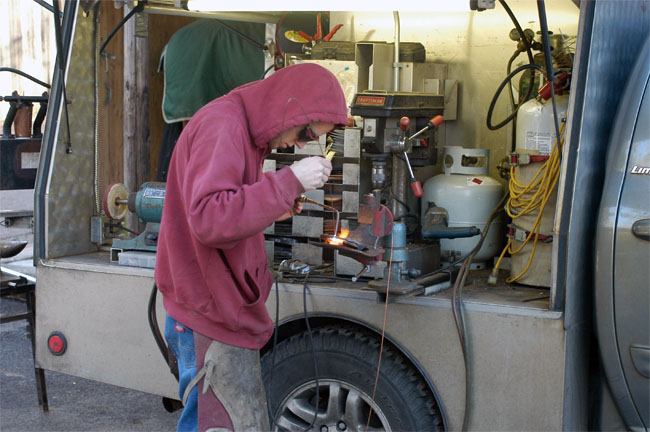
Apprentice Ben Fenstermacher uses a torch to weld a heart bar insert into place on a shoe for a jumper.
“You tend to forget just how big a commitment these things can be,” he says, as he pilots his shoeing rig through the building morning traffic. “It’s not just the time you put in during the events themselves. There’s the time getting ready, checking equipment, working with horses and riders, packing and more. I still enjoy the challenge, but it’s demanding. It takes a lot of time away from other things.”
Today’s scheduled barn calls are all in Pennsylvania. The previous day was spent largely in nearby New Jersey. Teichman says the service also works with some clients in Maryland, Virginia and Delaware. In addition, he and Meister will schedule weeks in Florida during the height of the winter show season.
7:17 a.m. Most of the horses Teichman shoes are high-end show horses — hunters, jumpers, three-day eventers and dressage horses. Teichman makes a stop for fuel and coffee, then gets on the Pennsylvania Turnpike and heads for his first stop.
Teichman says — at least so far — the slowing economy does not seem to have affected the horse-based economy in his area. He was able to pass on the cost of rising fuel prices to his clients without any significant complaints and hasn’t seen any marked decline in his work or in equine activity.

Teichman tries to get drainage from a deep-seated abscess on the hoof of a Morgan horse that has also had chronic founder problems as apprentice Fenstermacher looks on. An equine vet had sedated the horse.
He does believe that the economy may force the U.S. Equestrian Team to change some of its traditional scheduling.
“There isn’t a lot of money available right now,” he says. “I think the team will focus on getting ready for the Worlds in 2010 rather than going overseas for other competitions.”
The 2010 World Equestrian Games are scheduled for the Lexington Horse Park in Kentucky, the first time the U.S. will have hosted the prestigious event. The Worlds will be the largest equine event ever held in this country.
7:55 a.m. Teichman’s first stop is at Cedar Ridge Farms, where he and Fenstermacher are scheduled to shoe several jumpers and hunters. The farm in a hollow and the pastures sparkle with frost in the early morning sunlight as the shoers set up their shoeing equipment outside a stable. Jennifer, a trainer and barn manager, greets them and brings out Cash, a young gelding, who is only being shod for the second time.
8:02 a.m. Fenstermacher goes to work quickly, picking out the hooves and removing the shoes. Teichman goes over his schedule with Jennifer and sets out tools and shoes he expects to use. Once Fenstermacher has the shoes removed and the hooves cleaned up, Teichman steps in to trim the hooves. The shoes are being reset, so Fenstermacher takes them over to the shoeing rig to clean them up and level them.
As he works with his rasp, Teichman mentions that he’s a big believer in extending the life of his rasps by buffing them to help them retain an edge.
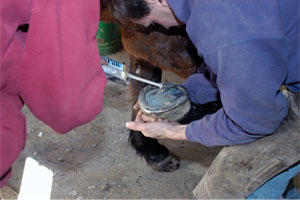
Because this Morgan horse was putting so much weight on his right foot because of the pain caused by the abscess in his left, Teichman fills the shoe with Equi-Pak to provide extra support and padding.
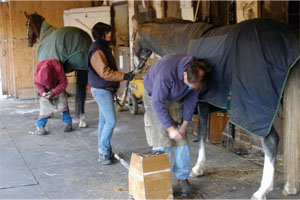
Teichman, foreground, checks the fit on a shoe as Fenstermacher finishes the hooves on a horse in the background. Teichman is one of the partners in Chester County Farrier Associates and emphasizes efficiency in his shoeing.
“I always emphasize that when I do clinics,” he says. “I’ll show people how I do it and it always seems that I’ll hear from someone later who tells me that was the best thing they got out of the whole clinic.”
8:27 a.m. Cash’s trimming and shoeing is relatively straightforward. Teichman heats the shoes in his forge and shapes them up before hot fitting them.
While the shoeing is straightforward, the horse does try to pull away during the hot fitting. Teichman tells Jennifer it has more to do with Cash’s inexperience with the process than it does with any real discomfort. After a few moments, Cash cooperates and Teichman is able to nail the shoes in place.
8:31 a.m. While Teichman was working on Cash’s front feet, Fenstermacher has gone on to remove the shoes from a second horse. The two now switch places, as Fenstermacher goes back to Cash to finish his front shoes and trim up his hinds.
Teichman isn’t one to waste time and he seems to have passed on the trait to the apprentice. There rarely seems to be a moment when the two aren’t working underneath a horse, safeing a shoe with a grinder mounted on a rig, or working at forge and anvil shaping a shoe for a better fit.
The well-honed teamwork soon sees both horses back in their stalls. Teichman points out that they spray the finished feet with a simple floor wax solution. It’s an inexpensive way to add a little shine as well as providing a moisture barrier.
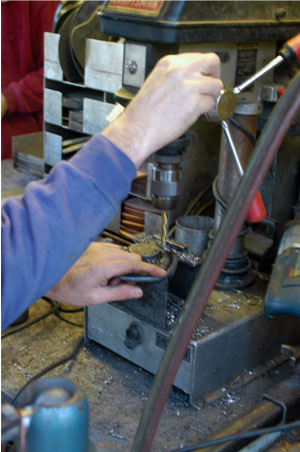
Teichman says the circular die mounted on the bed of his drill press makes drilling and tapping shoes for studs much easier. He’s able to slip the shoe around the die, keeping it level and in place as he drills his holes.

Teichman rapidly fans a torch across the sole of a foot to clean and toughen it before filling the shoe with Equi-Pak.
8:51 a.m. As Teichman prepares to work on a third jumper, Jennifer passed on a concern of his owner.
The horse has been shod with heart bar shoes filled with Vettec’s Equi-Pak for added support. But Jennifer says that the horse doesn’t seem to have been moving as well of late and doesn’t seem confident when jumping. The owner has asked Jennifer to see if adding Borium to the shoes might help with the issues.
Teichman examines the hooves, then has Jennifer lead the horse up and down the yard, first at a walk, then at a trot.
“I think we might be better off using a heart bar shoe with stud holes,” he tells her. “The studs can come in and out, but if we put Borium on, that’s permanent. We can take the Equi-Pak out for a while if she wants, but we’ll probably want to put it back in for the winter. Ice and snow would be brutal on the sole.”
Teichman tells Jennifer the horse has some issues, particularly behind. He’s stiff, low on the right side, possibly in the fetlock.
9:23 a.m. As Teichman takes the shoes to his shoeing rig to drill and tap the stud holes on his drill press, he points out a circular die that’s centered on the base of the press.
“That is a real handy thing,” he says. “It looks simple, but for doing things like drilling and tapping, it makes it so much easier to keep your shoe steady and level.”
9:31 a.m. As he places the shoe, Teichman explains that he uses a lot of heart bars with horses used as hunters or jumpers.
“On long-toe, low-heel horses like this, I don’t want to bring the toe back too much unless he has a good support mechanism in place,” he explains. “In this case, it’s the heart bar shoe.”
9:47 a.m. After the newly drilled and tapped shoes are nailed into place, Teichman again fills them with Equi-Pak, but this time, says he won’t quite fill the sole to the lip of the shoe.
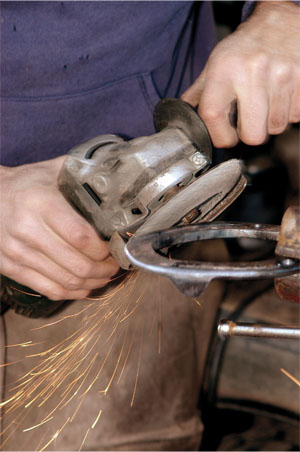
Teichman safes a shoe using a hand-held grinder.
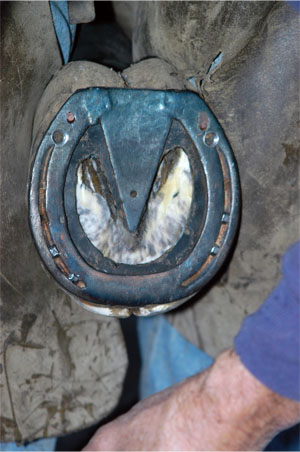
Teichman uses many heart bar shoes on the hunters, jumpers and three-day eventers that make up a big part of his shoeing book. He gets his heart bar inserts from a company that cuts steel using a plasma cutter. The company cuts the inserts from its own scrap steel in three different sizes for Teichman, who pays 30 to 40 cents apiece for them.
“That way the sole will still be protected,” he says. “But we’ll give him a little more cup to his foot. That should give him a little more traction,” he says.
10:13 a.m. Once the horse is done and returned to his stall, Teichman begins working on the front hooves of another horse that Fenstermacher has gotten ready for him.
This horse is being shod with a French-designed, aluminum-titanium alloy shoe. It features wider branches than many American-made aluminum shoes. Teichman explains that he only uses a few of these shoes — always at the request of an owner.
Teichman plans to glue on these shoes — and he admits that he’s not as careful about keeping the hoof clean as some farriers are with glue-ons.
“This is a pretty good product,” he explains, as he mixes up some Equilox II fast set to use on the shoes. “It’ll stick. I’ve know some guys take a lot of care cleaning off the hoof, keeping it dry. I’ve used glue-ons in all kinds of conditions; rain, mud, and rarely had any problems.”
Teichman says he is careful to clean the hoof properly at first, but doesn’t believe it’s necessary to use acetates or alcohol as part of that cleaning as some farriers do.
His rule of thumb is to use slow set when the temperature is 70 degrees or higher and slow set when it’s below 70. “That’s our cutoff point,” he says. He also will sometimes mix shredded fiberglass with the glue.
His rig also has a microwave oven that used to heat up Vettec Equi-Pak to make it easier to work with.
10:48 a.m. Teichman applies the glue to the shoe liberally and holds the shoe in place, wrapped with shrink-wrap, until it’s had time to set. He thinks some farriers are overly concerned about keeping the hoof clean.
“The glue only needs to stick as long as the life of an aluminum shoe,” he says.
11:43 a.m. Fenstermacher is finishing up the hooves of the last horse, as Teichman goes over the calendar with Jennifer, scheduling the next appointments for the six horses he’s taken care of today, as well as appointments for other horses at the barn that weren’t scheduled today.
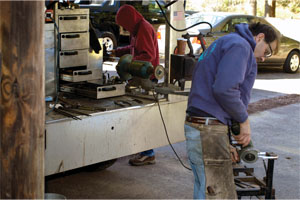
Teichman and Fenstermacher work off different sides of Teichman’s farrier rig. Teichman and his partner, Todd Meister, have their own rigs and take one to Florida for the winter show season. Each schedules one week a month in Florida during the show season and works out of the truck that’s kept there.
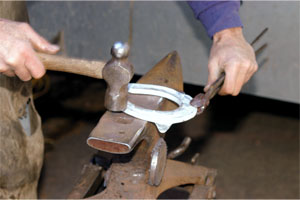
Teichman shapes a titanium-aluminum alloy shoe that glows white-hot when heated.
12:03 p.m. The farriers pack up the shoeing rig together. Fenstermacher makes sure everything is secure and swings down the gull-wing doors as Teichman enters his billing information on an Itronix tablet computer. He likes the versatility of the device, as well as its ruggedness. He’s hauled it all over the world.
“This thing can really take it,” he says, chuckling. “You can drop it, step on it — believe me, I’ve done them all — and it keeps on working.”
12:30 p.m. Teichman uses his cell phone to contact his next stop and let them know he’s on his way. He’s scheduled to stop in and check on a laminitic Morgan horse, who the owner says seems to be having more pain.
“We’ve been managing to keep his founder under control with some fairly aggressive shoeing,” Teichman explains. “He’s been in egg bars with some sole support. But now he seems to be developing some problems.”
Teichman makes a quick lunch stop for a sandwich he eats as he drives. During the trip to the next stop, he gets an audio alert from his rig’s GPS system that’s there’s a traffic delay ahead. The alert includes a suggested alternate route, which he quickly takes.
“Any farrier who does a lot of driving should have one of these,” he says, nodding toward the GPS display unit that’s mounted on the dash. “It seems that at least once a week, it lets us know about a traffic problem ahead and saves us an hour. They don’t take long to pay for themselves.”
Teichman says the GPS is helpful when he’s in unfamiliar territory, or when his scheduled route is interrupted due to a cancellation or emergency.
He admits he also found out that some of the routes he’d always assumed were the shortest distances between a couple of stops, in fact, weren’t.
1 p.m. When Teichman arrives at the barn where the ailing Morgan is stabled, he finds the horse’s equine veterinarian is also on hand. Teichman points out that the horse has the classic signs of a horse with Cushing’s issues: a thick, cresty neck, very hirsute coat and fat deposits along the back and neck.
Teichman inspects the horse along with the veterinarian. After a brief consultation, the farrier gets out his hoof testers and checks for painful areas.
He finds a pronounced sensitivity in one quarter — despite the fact that the horse has already been given Bute by the veterinarian.
“This foot is also really hot,” explains Teichman as he looks at the foot. “You can also look at the white line here and can see the laminae are really stretched.”
Teichman tells the veterinarian that he thinks the horse’s obvious pain is probably due to an abscess as well as laminitic issues. He uses his hoof knife to carefully dig into the area and gets a little seepage, but says it appears the abscess is too deep within the foot to justify digging in too far.
1:23 p.m. The veterinarian and Teichman discuss packing the opposite front foot with Equi-Pak to try and give it added protection because the horse is throwing so much of his weight on to it in an effort to protect the painful limb.
The vet blocks the left foot so that the Morgan can be persuaded to pick up his right front, enabling Teichman to fill the egg bar shoe with the Equi-Pak.
“There’s not a lot more that we can do until that abscess erupts,” he tells the veterinarian and barn crew. “Unfortunately, it looks as if it’s going to erupt near the coronary band.”
1:39 p.m. After repacking the truck, Teichman heads for his final stop of the day. He and Fenstermacher are scheduled to shoe two more horses at this stop, which will mean that they’ve seen nine for the day — including two trims.
“During this time of the year, that’s fairly normal,” he says. “But up until the beginning of October, probably 70% to 80% of the time, we’re shoeing 12 horses a day and doing some other stuff besides.”
In early December, one of the partners will drive a rig down to Florida, where it will be kept during the show season.
“We’ll each go down there one week out of a month,” he explains. “I’ll schedule my horses so that I can do them while I’m down there and Todd will do the same. But if anything comes up with his horses while I’m down there, I can check up on it, and he’ll do the same for me if he’s down there.”
The partners will move the truck in Florida as needed — in the Wellington area for one week and to Ocala later, for example. As the season shifts back north in the spring, they’ll move the truck back to Pennsylvania, usually scheduling the move so that the farrier moving the truck can stop at the shows in Georgia or the Carolinas, where their clients’ horses will be performing.
2:03 p.m. Teichman says that the size of Chester County Farrier Associates has varied somewhat over the years.
“Right now, I think this is about the best size,” he says. “It seems to be working the best. We’ve had three and four farriers working at one time along with some assistants, but right now with just the two of us, two assistants and Jessica running the office, we seem to be the most efficient and profitable.”
One aspect of improving efficiency involved moving the offices to Downingtown from a previous location.
“That put us closer to the majority of our clients,” he explains. “We used to have the office at my place, along with a workshop and a forge. But it was expensive to equip the workshop and we found it wasn’t really getting used that much. It seems to make more sense to just work out of the trucks.”
Teichman also believes that the smaller operation has been better in other areas, including inventory control. He notes that the advantages to buying supplies in bulk can be lost if that buying isn’t done with some goals in mind.
“We used to get into situations, for instance, when one guy would start buying a lot of a certain type of shoe. There was a tendency to say, ‘Well, if I don’t use all of these, one of the other guys will.’ But that wasn’t always the case.”
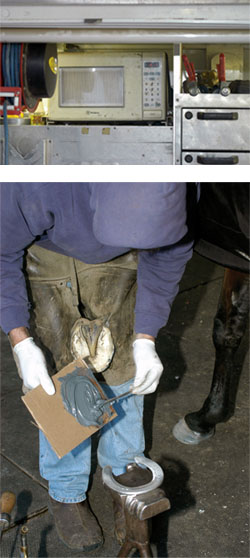
Teichman’s rig is equipped with a microwave oven to heat Vettec Products. While he applies glue-on shoes carefully, he doesn’t worry as much about meticulously cleaning the foot as some farriers do. He’s glued on shoes in mud and rain and has never had any serious problems.
Teichman recalls that when the business was moved to its current headquarters – shortly after the number of farriers involved was reduced — they found they had a lot of shoes in inventory that had been there a long time.
“It’s not a total loss,” he says. “They’re shoes. They’re metal. They don’t go bad. What we’ve done is make an effort to get them used.”
That meant modifying some of the shoes so that they could be used for horses and purposes other than those they were originally purchased for. Teichman says doing so was a much better solution than simply letting them slowly rust away unused on racks, or selling them for their scrap metal value.
And while the shoeing rig Teichman is driving looks fairly typical — a Stone Well shoeing body mounted on a pick up truck — he points out that it isn’t loaded with frills.
“When I was up at Stone Well getting this one, Brent (Chidsey) said, ‘You know this is the cheapest one I’ve built in a long time,’” Teichman recalls with a laugh. “But it has everything I need to do my work.”
3:02 p.m. Teichman’s final stop of the day is to shoe two horses for JoAnne Nightengale, a horsewoman and owner of Plum Shade Farms, who makes and markets a number of hoof-care products. She’s very attached to her horses, including one who, according to Teichman, has “a lot of metabolic issues.”
“There are times he shakes and shivers so much he’s hard to work on,” says Teichman.
3:11 p.m. Today, the horse seems to be feeling pretty good. Teichman is able to go to work on him quickly. Nightengale, who arrives shortly after the farriers start their work, credits Teichman with being instrumental in keeping the horse sound.
Teichman says that’s required a number of adjustments. At times, the horse has had a tendency to drag his toes and turn out. Teichman points out that one of the shoes he’s resetting has three clips, to help counter any shearing forces caused by that twisting.
3:23 p.m. Both horses are very cooperative and Teichman and Fenstermacher are able to get their trimming and shoeing work done relatively quickly. While Teichman is resetting the shoes on the first horse, Fenstermacher gets started on the second horse. Once again, there’s no wasted time or effort. Teichman stays focused on his shoeing work, even while he’s chatting with Nightengale about her performance at a recent horse show.
3:47 p.m. The farriers have finished their last stop of the day and are on their way back to the office. Teichman mentions a couple of things they should make sure to replenish in the rig when they return. He notes that today was an easier day than the previous one. Then, they had been on the road for New Jersey at about 5 a.m. and had not made it back to the office until much later than they will today. To make the day even longer, Teichman attended a class in printmaking after his day’s work. Tonight, he’ll extend the day by taking his son to karate class.
4:02 p.m. During the drive back to the office, Teichman talks about some of what he’s learned from shoeing in so many different international competitions — such as respect for different types of shoeing. He’s come to believe that no one method of shoeing can work for all horses in all places.
“Horses who are used in international competition have to perform in a lot of different climates,” he notes. “Their feet and hooves never really adapt to one climate before they’re moved to another. What seems to work fine in one place, may not work at all in another.”
He also says the way he looks at shoeing has changed over the years. He’s an American Farrier’s Association Certified Journeyman Farrier and was once very active in shoeing competitions, earning spots on the American Farrier’s Team.
“I used to be really focused on that,” he recalls. He says he had an epiphany when he first started shoeing horses for international competitions.
“I came to realize that the riders don’t care if they have perfect, hand-made shoes,” he says. “They want shoeing that allows their horses to perform. With shoeing competitions, you sometimes spend hours practicing making shoes that you’re never going to use. That’s not where the focus needs to be.”
Even in a craft known with a well-earned reputation of being composed of an eclectic mix of people, Teichman is unusual. In addition to attending Warrington Farrier School in 1975 and completing an internship on advance farrier science at the University of Pennsylvania’s New Bolton Center, he holds a bachelor’s degree in biology from Eastern College (now Eastern University) in St. Davids, Pa.
He’s also studied karate and artistic engraving. In the cab, he has several intricately engraved bracelets that he’ll be delivering to buyers. He also engraves prints, knives and hoof knives , as well as other items. He’s currently working on a hoof knife that he’s donating to the annual AFA auction.
Looking at the bracelets, you might expect that Teichman would want every shoe he nails or glues on to a horse’s hoof while Shoeing For A Living to be a work of art. And in a way, he does.
He wants every shoe to enable the horse to perform at his best — and that he believes makes the shoe a real farrier’s masterpiece.

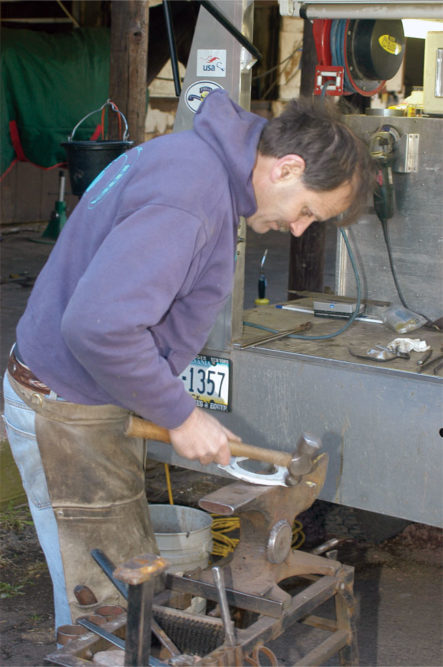
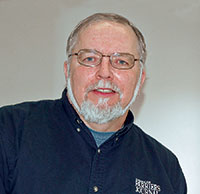






Post a comment
Report Abusive Comment